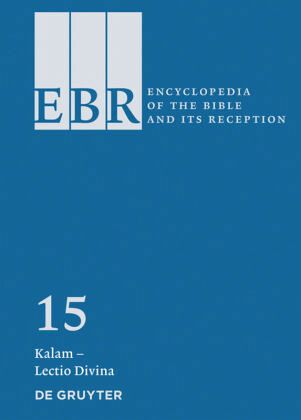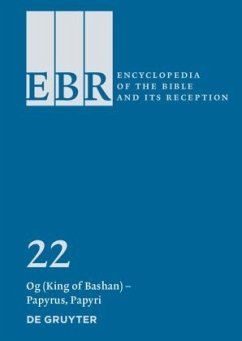Nicht lieferbar

Kalam - Lectio Divina / Encyclopedia of the Bible and Its Reception (EBR) Volume 15
Versandkostenfrei!
Nicht lieferbar
The projected thirty-volume Encyclopedia of the Bible and Its Reception (EBR) is intended to serve as a comprehensive guide to the current state of knowledge on the background, origins, and development of the canonical texts of the Bible as they were accepted in Judaism and Christianity. Unprecedented in breadth and scope, this encyclopedia also documents the history of the Bible's interpretation and reception across the centuries, not only in Judaism and Christianity, but also in literature, visual art, music, film, and dance, as well as in Islam and other religious traditions and new religio...
The projected thirty-volume Encyclopedia of the Bible and Its Reception (EBR) is intended to serve as a comprehensive guide to the current state of knowledge on the background, origins, and development of the canonical texts of the Bible as they were accepted in Judaism and Christianity. Unprecedented in breadth and scope, this encyclopedia also documents the history of the Bible's interpretation and reception across the centuries, not only in Judaism and Christianity, but also in literature, visual art, music, film, and dance, as well as in Islam and other religious traditions and new religious movements.
The EBR is also available online.
Blogger's Choice - Articles recommended by biblioblogger Jim West (https://zwingliusredivivus.wordpress.com)
Following in the tradition of earlier volumes in this highly useful and extraordinarily important series, volume 15 provides a virtual lifetime of scholarship for students of the Bible and its reception."
Karlstadt, Andreas Bodenstein von (Frank M. Hasel; Silver Spring, Md., USA)
Hasel notes the core difference between Luther and Karlstadt when he writes "What Luther would permit, Karlstadt would compel; where Luther would introduce changes and innovation gradually, Karlstadt would push for direct action." It's a keenly and smartly written distillation of a very complex life Hasel here provides.
https://www.degruyter.com/view/EBR/MainLemma_8346
Kataphatic Theology I. Christianity (Christophe Chalamet; Geneva, Switzerland)
"Kataphatic theology affirms something about God, on the basis of God's condescending movement or as an attempt to bring God down to the level of human language." Chalamet then describes that dogma as it manifests itself in Christian theology in a quite accessible way.
Kennicott, Benjamin (Anselm C. Hagedorn; Osnabruck, Germany)
Hagedorn's very concise biography of Kennicott presents a lot of information in a short entry. As is the case of so many of the EBR's entries, a little goes a very long way.
Killigrew, Anne (Rafael Vélez Núnez; Cadiz, Spain)
Anne Killigrew (1660-1685) was an English Restoration poet and painter. "Anne Killigrew's painting and poetry voice a heroic female world alien to libertinism." Another example of a person with whom I was not familiar and yet now find myself very intrigued by: a strong woman in a time when being such was both unique and potentially hazardous.
Kiss VIII. Film (John Boyles; Abilene, Tex., USA)
The 'biblical kiss', as it appears in film, is the subject tackled by Boyles (after other authors examine it in the Bible, Judaism, Christianity, music, etc.). "Two categories of kiss from the Bible appear on film. First are scenes of familial or intimate kissing. ... Second are scenes of kisses within a religious context..." The carefulness and thoroughness of the Encyclopedia are once again on display here. There is simply so much fromthe Bible which has impacted literally every corner of modern life.
https://www.degruyter.com/view/EBR/MainLemma_666
Labor (Childbirth) IV. Christianity E. World Christianity (Joanne Davis; London, United Kingdom)
Davis notes in her contribution focusing on World Christianity, that "There are two concerns in World Christianity with respect to the biblical reception of labor and childbearing. The first concerns the significance of passages in the Bible ... The second concern is the great incidence of maternal and infant death in childbirth." Her description in what follows is incr
The EBR is also available online.
Blogger's Choice - Articles recommended by biblioblogger Jim West (https://zwingliusredivivus.wordpress.com)
Following in the tradition of earlier volumes in this highly useful and extraordinarily important series, volume 15 provides a virtual lifetime of scholarship for students of the Bible and its reception."
Karlstadt, Andreas Bodenstein von (Frank M. Hasel; Silver Spring, Md., USA)
Hasel notes the core difference between Luther and Karlstadt when he writes "What Luther would permit, Karlstadt would compel; where Luther would introduce changes and innovation gradually, Karlstadt would push for direct action." It's a keenly and smartly written distillation of a very complex life Hasel here provides.
https://www.degruyter.com/view/EBR/MainLemma_8346
Kataphatic Theology I. Christianity (Christophe Chalamet; Geneva, Switzerland)
"Kataphatic theology affirms something about God, on the basis of God's condescending movement or as an attempt to bring God down to the level of human language." Chalamet then describes that dogma as it manifests itself in Christian theology in a quite accessible way.
Kennicott, Benjamin (Anselm C. Hagedorn; Osnabruck, Germany)
Hagedorn's very concise biography of Kennicott presents a lot of information in a short entry. As is the case of so many of the EBR's entries, a little goes a very long way.
Killigrew, Anne (Rafael Vélez Núnez; Cadiz, Spain)
Anne Killigrew (1660-1685) was an English Restoration poet and painter. "Anne Killigrew's painting and poetry voice a heroic female world alien to libertinism." Another example of a person with whom I was not familiar and yet now find myself very intrigued by: a strong woman in a time when being such was both unique and potentially hazardous.
Kiss VIII. Film (John Boyles; Abilene, Tex., USA)
The 'biblical kiss', as it appears in film, is the subject tackled by Boyles (after other authors examine it in the Bible, Judaism, Christianity, music, etc.). "Two categories of kiss from the Bible appear on film. First are scenes of familial or intimate kissing. ... Second are scenes of kisses within a religious context..." The carefulness and thoroughness of the Encyclopedia are once again on display here. There is simply so much fromthe Bible which has impacted literally every corner of modern life.
https://www.degruyter.com/view/EBR/MainLemma_666
Labor (Childbirth) IV. Christianity E. World Christianity (Joanne Davis; London, United Kingdom)
Davis notes in her contribution focusing on World Christianity, that "There are two concerns in World Christianity with respect to the biblical reception of labor and childbearing. The first concerns the significance of passages in the Bible ... The second concern is the great incidence of maternal and infant death in childbirth." Her description in what follows is incr




